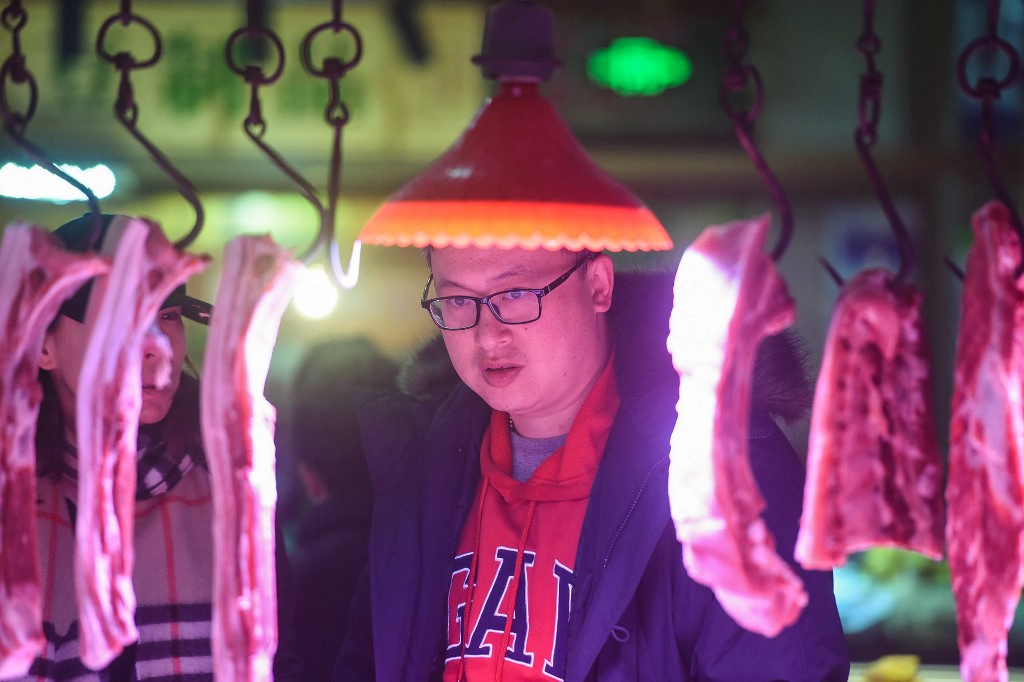China has made numerous claims in recent months that packaging on imported meat and fish shipped from abroad via cold storage freight has been infected with coronavirus.
A recent case led to the closure of Shanghai’s main airport and various food markets and other areas across China have been closed for the same reason.
On November 25, Chinese officials also claimed the recent outbreak in Kashgar started with a ‘patient zero’ who worked with freight containers.
However, international experts have said it is “unlikely” the coronavirus would survive such conditions, but no major official global health organisation has been able to prove or disprove the theory.
The World Health Organisation says coronavirus will not survive cooking, but the Chinese claims relate mostly to packaging, such as cardboard, saying it is sometimes carries the virus.
This month the port city of Tianjin added one newly confirmed local case – a worker at Tianjin Hailian Frozen Food. On November 24, Zhang Ying, deputy director of the Tianjin Centers for Disease Control and Prevention, told media that the source of infection was determined to be imported pigs’ heads from North America.
China’s Import and Export Food Safety Bureau said that Customs had strengthened the quarantine of imported cold-chain foods and suspended the export of products from companies where a cluster of employees had been infected.
The import of food via cold chain logistics has raised questions, according to Jianmian.com. Some citizens are asking on social platforms such as Weibo and Zhihu why China cannot simply stop importing food via the cold chain logistics system.
State media outlets say it is impossible for importers of cold-chain food to “adopt a one-size-fits-all shutdown measure.”
This is because to a large extent imports have the effect of supplementing domestic supply and demand and stabilising prices.
Pork, for example, was hit by a shrinking supply of live pigs this year in China due to swine flu, so the demand for imports has been even stronger. And China’s harvest of various crops was badly affected by huge floods in the Yangtze basin and other areas, as well as locusts and other issues this year.
China imported 2.9 million tonnes of pork between January and August this year, according to Customs data, which is an increase of 133.7% over the same period last year. The import volume in May rose by 86%, but the year-on-year growth rate in all other months this year exceeded 100%.
Shortage of pigs, imported pork cheaper
Meanwhile, the National Bureau of Statistics said that in the first half of this year the number of pigs bred for slaughter and pork production decreased by nearly 20% year-on-year. And the shortage of pigs is likely higher than official statistics, given the increase in imports and prices earlier in the year.
At the stage when the Covid-19 epidemic in China first stabilised and consumption was accelerating, major pork exporting countries such as the United States, Canada, Brazil, Spain and Germany had obvious advantages because of the lower price of their pork.
The average price of imported pork in China has fallen from 22.40 yuan per kilogram in January to 16.50 yuan in August. This is low compared with the average domestically raised pork price of 48.42 yuan per kilo at the end of August.
Imported pork is simply cheaper, but the downside is that meatpacking plants in countries such as the US and Germany have seen large coronavirus outbreaks. So the theory is that employees are shedding virus onto packaging or other items.
The same is true for poultry meat. In the first eight months of 2020, China purchased $418 million worth of poultry products from the United States, according to data from the USA Poultry and Egg Export Council. And China bought 280,000 tonnes of poultry products, accounting for 12% of total exports – a five-year high. The imports also played a role in stabilising prices in China.
Chicken feet
Another case is chickens’ feet, which are popular with consumers in China and elsewhere in Asia, but a largely unwanted byproduct in the west, where breasts and drumsticks are popular products.
According to Customs data, in the first 10 months of 2019, China imported 625,000 tonnes of frozen chicken, of which 210,000 tonnes were wings and 160,000 tonnes were feet.
China is not only the world’s largest pork consumer, but also has the world’s largest demand for pigs’ feet, which are regarded by Chinese consumers as a delicacy, whereas they are often mixed with pig offal and other byproducts to make pet feed in many other countries, or treated as waste products. That means imported pigs’ feet are cheap.
Ma Wenfeng, a consultant at Beijing Oriental Agribusiness, said that imported trotters are 50% cheaper than domestic trotters.
Therefore, it is not realistic to completely cut off imported cold-chain food products in order to prevent the spread of coronavirus, state media outlet Jianmian.com reported.
‘Covid survives low temperatures’
At present, China Customs officials have increased the inspection of cold-chain food products from abroad.
Li Ning, deputy director of the National Food Safety Risk Assessment Centre, said departments and localities have recently increased their detection and sampling of imported cold-chain food, plus its outer packaging for the virus. As the frequency and coverage of the detection increase, the probability of finding a positive has also increased.
“This shows that the measures taken by China to strengthen physical defence are very effective,” Li said. But the current positive rate from random inspections across the country was just 0.48 cases per 10,000, and they mainly focus on food packaging.
Food is now often sold with QR codes showing the point of origin. In regard to concern about consuming imported cold-chain meat, Wu Zunyou, chief epidemiologist at the China Centers for Disease Control and Prevention, said that imported cold-chain foods sold on the mainland were all tested products and safe.
Meanwhile, Wang Guiqiang, director of the Department of Infectious Diseases at Peking University First Hospital, said there was currently no evidence that people could get a coronavirus infection via their digestive tract. Meat, eggs, fish, and seafood were safe and could be eaten with confidence.
But, the supply chain of imported frozen food is still affected after the State Council on November 8 ordered mass testing. All goods need to be sterilised and undergo a nucleic acid test. Goods have to be picked up at a warehouse rather than directly from the port, adding to costs – sterilising a container costs 2,000 yuan – as well as delivery times and payment cycles, affecting small businesses.
The customs clearance process takes longer, because of testing and comprehensive sterilisation, and some goods also see costs rise due to clearance fees. “In the past, customs clearance required a week in line, but now it only depends on luck,” said one worker.
• Chris Gill.
This page was upgraded on January 31, 2022 for style purposes.
ALSO SEE:
Growing shortages and rising food prices in China
‘Don’t waste food’ edict raises fears of China food crisis
China claims to find coronavirus in imports of chilled meat
























